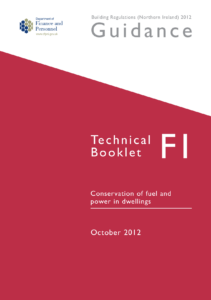Accuracy as standard
Professional and reliable air tightness testing in Northern Ireland
Accurate air tightness testing, without the fuss
Air tightness is the uncontrolled movement of air in and out of a building. Commonly this air escapes through gaps or cracks in the building fabric. Air tightness testing aims to address an inherent environmental impact and contribute to lowering the carbon footprint of a building.
Air tightness testing provides an accurate understanding of the amount of air lost in a building. This test, which is also referred to as air permeability testing or air pressure testing, gives a result expressed as a quantity of air leakage (m3 per hour) per square metre of building envelope.
Building sustainable buildings and neighbourhoods is important for our economy, quality of life, environmental stewardship and climate change resilience.
Excessive air leakage can lead to:
- Unwanted heat loss
- Increased heating and energy costs
- Colder homes
- Greater CO2 emissions (resulting from additional heating)
Request a Quote
How much does air tightness testing cost?
As well as providing fast, reliable and accurate air tightness testing across Northern Ireland, we also offer an industry-leading price starting at only £295.
Further to your assessment, our qualified assessors will be happy to assist you with free advice regarding any air leakage or heat loss.
Sub-optimal airtightness can be responsible for up to 40% of heat loss from buildings. This increases energy costs in homes across Northern Ireland.
Why is air tightness testing required?
Air Tightness Testing (Statutory Assessment Procedure) is the UK Government’s recommended method system for measuring the energy rating of residential dwellings.
Air tightness testing became required as part F1 building regulations in Northern Ireland in 2006. This was updated in SAP 2012 building regulation standards and is now used as the basis for checking new dwellings for compliance with building regulations in Northern Ireland.
From this point, all newly constructed buildings must achieve the pass rate before acquiring building control approval. A pass on this test is usually 10 m³ per hour per metre squared at 50 pa.

Air Tightness Testing Across All Of Northern Ireland
Our team of partner air tightness testing experts are based right across Northern Ireland. We pride ourselves on quick response, a prompt and accurate service to support your business.
Each of our air tightness testing partners have years experience in meeting building regulations through air tightness testing. All of our testing partners are iATS registered which ensures accuracy and guarantees the quality of their work.
Air Tightness Testing Methods
Our network of air tightness testing professionals uses a variety of equipment to accurately test air leakage in properties. The most common air tightness testing solutions are the Pulse testing units and the more familiar fan pressure testing systems.
Depending on your location, the type of building to be tested and the professional testing your building, we may use either of these methods.
Air Tightness Pulse Testing
Pulse testing is a relatively newer method of air tightness testing using a pressure shockwave to test the air tightness score.
Instead of using a door fan which is the more traditional method, a small device is placed in the centre of the property. This device emits a pressure shockwave and then collects the data from the pulse.
Pulse testing provides a dynamic measurement of air leakage at a pressure level that is more representative of real-world year round conditions.
Air Tightness Fan Pressure Testing
Air tightness testing is critical to achieving an optimal final air tightness and energy efficiency rating.
Using fan pressure testing our blower door testing equipment is installed to pressurise the building and test pressure differences. The data is recorded and this further helps us to identify areas of concern or air leakage.
Areas Covered Across Northern Ireland
- Belfast
- Derry / L’Derry
- Craigavon
- Newtownabbey
- Bangor
- Castlereagh
- Lisburn
- Ballymena
- Lurgan
- Newtownards
- Carrickfergus
- Newry
- Coleraine
- Antrim
- Portadown
- Omagh
- Larne
- Banbridge
- Armagh
- Dungannon
- Enniskillen
- Strabane
- Limavady
- Cookstown
- Holywood
- Downpatrick
- Balymoney
- Ballyclare
- Comber
- Magherafelt
- Warrenpoint
- Portstewart
- Newcastle
- Carryduff
- Donaghadee
- Kilkeel
- Portrush
- Dromore
- Ballynahinch
- Greenisland
- Ennikillen
- Moira
- Whitehead
- Ballycastle

